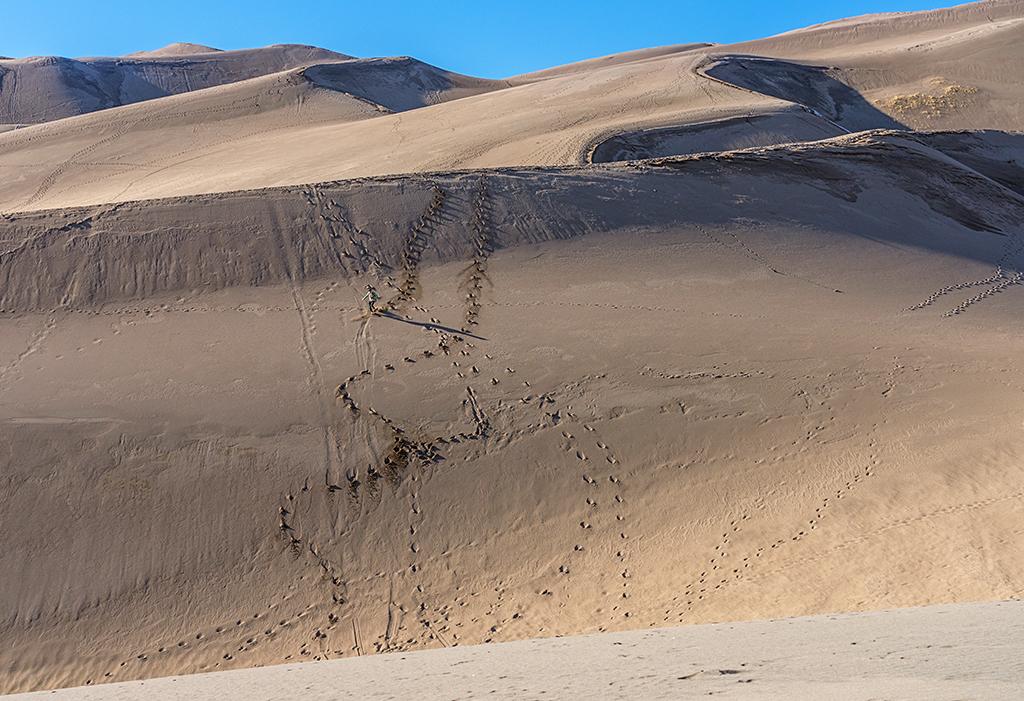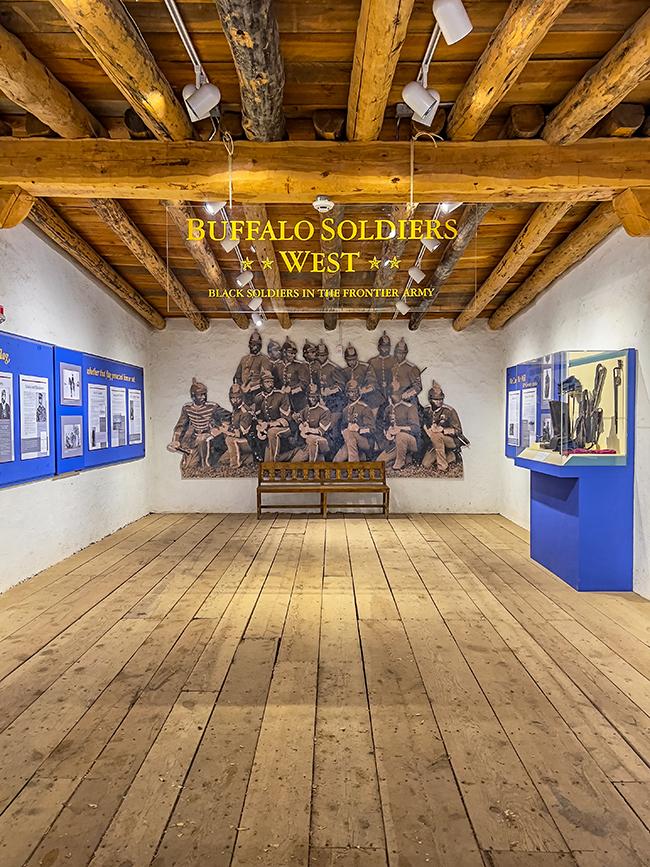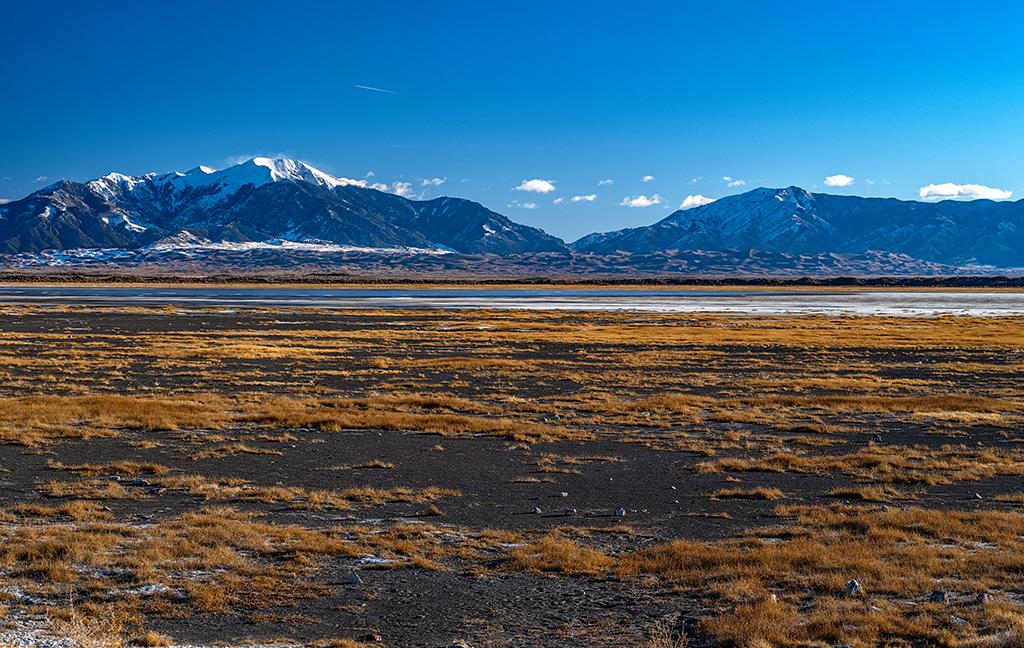
A mid-morning winter scene at Great Sand Dunes National Park and Preserve / Rebecca Latson
Peruse any of the brochures or website images for Great Sand Dunes National Park and Preserve in Colorado, and you’ll see the smiling faces of adults and kids having summer fun surfing Medano (MEH-duh-no) Creek or sand sledding down a steep dune. There’s something to be said, however, for spending a few winter days at this national park. Crowds are non-existent (have you seen the late spring / early summer congestion the park can get?) and there’s plenty of solitude. Add to that the stunning juxtaposition of Sahara-like dunes up which you can hike and slide down (even in cold weather), nestled against the base of the snowcapped, toothy Sangre de Cristo Mountains, and it’s a picturesque park you should put on your must-see list. During winter!
Although many, if not most, of the trails are snowed under and Medano Creek is dry with several inches of ice and snow blanketing the creek bed, the park is open year-round, and the dunes are available for hiking and sledding. If you enjoy photography, winter is a fine time for stunning sunrises, sunsets, and dune & mountain imagery. If you are a history buff, there’s nearby Fort Garland Museum & Cultural Center telling the story of the fort and the 9th Calvary Buffalo Soldiers who patrolled the Great Sand Dunes region from 1876 – 1879. Depending upon your time of arrival, you might even be around when thousands of sandhill cranes visit the area during their annual migration. There’s enough to see and do within and near the national park for you to spend a good three days’-worth of winter exploration. Just don’t forget to set your watches and clocks to Mountain Standard Time.
Getting There

Map of Great Sand Dunes National Park and Preserve / NPS
Located in Colorado’s San Luis Valley, Great Sand Dunes National Park and Preserve can be reached via commercial plane flight to Denver or Colorado Springs in Colorado, or to Albuquerque, New Mexico, then rental car for the remainder of your journey to the park. You may also fly into San Luis Valley Regional Airport in Alamosa, Colorado, located 31 miles from the park, but flights are limited. Drive times from the larger airports range between three-to-five hours.
Note: Regarding rental cars, it’s a good idea to find out if the nearest community at which you lodge has EV charging stations, should the rental company assign you an electric vehicle. The rental company I used initially assigned an electric vehicle to me, but I had not even considered an EV and was unsure as to whether Alamosa (where I stayed), offered any EV charging stations. I eschewed an electric vehicle for a gas-powered one and later learned Alamosa has three different EV charging stations (according to Google).
What To Pack
I visited in mid-February, and while my entire week there was mainly sunny and clear, morning temperatures were down to single digits. While the day gradually “warmed” to between 26° - 41° F (-3° – 5° C), the constant wind kept things on the brisk side. With this in mind, it’s a safe bet packing fleece, base layers, warm socks, gloves, an insulated jacket, and a warm hat or balaclava hood (jeans and sneakers are not really recommended for the season). Boots and traction devices (e.g. Yaktrax or Kahtoola brands) will help you over ice and snow and even frozen sand. While climbing the sand dunes is easy (certainly nothing compared to the slog getting up the Cinder Cone Trail in Lassen Volcanic National Park), a hiking stick or pair of poles help ease the uphill effort while possibly preventing a head-over-heels slide down a steep dune face. Sunglasses are requisite wearing for sunny days on snow and sand as well as preventing eye irritation from the incessantly-blowing, biting winter wind.
Lodging
Spring and summer are filled with lodging choices, from camping, to Airbnbs, to standard hotel/motels. Winter months, on the other hand, offer fewer lodging choices near the park. In-park Piñon Flats Campground, as well as area camping outside the park are not open until the warmer months of May and April. Brick-and-mortar lodging choices depend upon your basecamp location. For more consistent lodging choices, you’ll want to check availability at Alamosa, Monte Vista, or Fort Garland. The small community of Crestone, located near the north side of Great Sand Dunes, offers Airbnb-type accommodations. Click here for more information about places to stay around the park.
Where To Eat
I stayed in Alamosa, with a population of about 9,000. There are all sorts of eating establishments in this town, from family dining (Chinese, Thai, Mexican, American, brewpub), to fast-food KFC, McDonalds, Arby’s, Sonic. There’s also Safeway, City Market, and Wal-Mart Superstore grocery stores, and a Starbucks (satisfying my need for caffeine during my stay).
Winter Activities Day 1

A telephoto sunrise over Great Sand Dunes National Park and Preserve / Rebecca Latson
Ok, let’s say you have three winter days to spend at Great Sand Dunes. If you tote a camera or smartphone, why not leave early in the morning to capture sunlight’s ruby glow gracing the tips of the snowcapped Sangre de Cristo Mountains before sliding down to bathe the sand dunes with bright, golden light. There are numerous pullouts along the road into the park and past the entrance station for different dune and mountain perspectives. Stand still for a moment and you might hear the distant barking/yipping of coyotes … or maybe just listen to the profound silence.

The Visitor Center, Great Sand Dunes National Park and Preserve / Rebecca Latson
After spending a little time for sunrise shots, drive to the park’s visitor center to see what ranger-led programs are offered. Watch the park’s video then walk around the large diorama of the park and preserve’s ecosystems. Read those informational cards around the diorama to learn fun trivia, such as picking up magnetite grains in the dune sands with a magnet.
Step out back of the visitor center for yet another, closer view of the landscape. There’s even a nature trail leading to the Dunes Parking Area but it will probably be snow-and-ice covered, as it was during my visit. While there are no trails out to or on the dunes (that’s right – just head on out into the sand wherever your heart directs), there are some forest and alpine trails in the park which will probably be covered in snow and take a bit of work to traverse.
Drive to the Dunes Parking Lot and go climb some dunes. Again, there are no trails. It’s like one giant sandbox. You can even take your dog (always leashed). Remember to carry poop bags and clean up after your pet. While hiking the dunes, you might see people using toddler-sized, inflatable swimming pools or sand boards to slide down the velvety-soft sand. You might also see people simply running full tilt down the dunes with wild abandon.

Full tilt down dune, Great Sand Dunes National Park and Preserve / Rebecca Latson
Look at the landscape while climbing those dunes. Observe vegetation clinging to the sandy surface, ripples and other abstract wind-and-water artwork, and wildlife footprints to and from the dune tops. What are those black lines and patches on an otherwise matte-beige color scheme? Hint: magnetite grains. Note the velvety, tiny sand grains versus the larger rounded grains versus actual pebbles strewn across the sandy floor. According to the National Park Service, “Most sand comes from the San Juan Mountains, over 65 miles to the west. Larger, rougher grains and pebbles come from the Sangre de Cristo Mountains.”

Sand and pebbles, Great Sand Dunes National Park and Preserve / Rebecca Latson
Before leaving for the day, stick around just a bit longer for sunset and maybe even “blue hour,” when the sky and landscape are bathed with after-sunset colors of blue, pink, and purple. A great wide-angle view of the entire sand dune/mountain landscape is at a pullout immediately after the turnoff from Colorado State Highway 150 onto Lane 6 N (toward Mosca). Sunrise, sunsets, and blue hour views are all wonderful compositions at this spot.
If it’s a clear night, stay to photograph the stars studding the dark sky canopy. Great Sand Dunes is an International Dark Sky Park.
Winter Activities Day 2

One of the Buffalo Soldiers exhibits at Fort Garland Museum & Cultural Center / Rebecca Latson
Explore the local areas near the park. Drive to the community of Fort Garland and tour their museum & cultural center, opened to the public in 1950. Five adobe buildings remain of the 22 original structures comprising the nineteenth century military fort. Stationed at Fort Garland from 1876 – 1879 were the 9th Cavalry Buffalo Soldiers, who patrolled the landscape around Great Sand Dunes, protecting both settlers and Native American tribes. You can spend anywhere from thirty minutes to an hour roaming the buildings and viewing the soldiers’ and officers’ eating and sleeping areas as well as displays of uniforms, rifles, and personal affects belonging to the men, while reading about those lives within and beyond the fort’s borders. There’s a bookstore and small gift shop at the museum’s entrance.
Head back toward the park along Colorado State Highway 150, but take the left turnoff onto Lane 6 N west to the San Luis Lake State Wildlife Area, halfway between Mosca and the turnoff. Park your vehicle at the picnic area and walk toward the boat ramp. Closed to boating in the winter, you can stand on the concrete ramp for a great view of the four major geological components of Great Sand Dunes National Park and Preserve: mountain watershed, dunefield, sand sheet, and sabkha.

A view of Great Sand Dunes National Park from San Luis Lake State Wildlife Area / Rebecca Latson
Returning the way you came, stop off at the LB Bill Casselman Historical Landmark, just before the turnoff onto Highway 150, and read the roadside exhibits while taking in the 360-degree view of the San Luis Valley, national park, Sangre de Cristo Mountains, and far-off San Juan Mountains. At this spot, you can really feel the wide-open spaces and loneliness of the windswept landscape. As a matter of fact, make it a point to stop at all the roadside exhibits along Highway 150 to learn about the history of the area.
If you enjoy birding and bird photography, check out the Alamosa National Wildlife Refuge located six miles (10 km) east of the town of Alamosa, or the Monte Vista National Wildlife Refuge some eight miles (13 km) south of the town of Monte Vista, for birdlife and wetlands landscape viewing. Time your visit around the last week of February and into early March, and you might have the pleasure of viewing large groups of sandhill cranes arriving in the San Luis Valley during their annual migration through the area. There’s also the possibility of elk, coyote, porcupine, and eagle sightings.
If you feel like a stretch of the legs, turn off State Highway 150 and drive to the Zapata Falls trailhead for a 0.9-mile out-and-back hike to a secluded waterfall. Winter means Zapata Falls may be totally frozen and dictate traction spikes for the hike.
Winter Activities Day 3
Return to the park for a final day of capturing sunrise, hiking the dunes, enjoying that last sunset and perhaps blue hour and the night sky one more time before heading home the next day.
Winter at Great Sand Dunes is quiet, with an abundance of solitude, no crowds, and plenty of parking. If you are looking for peace and quiet within a unique setting, then this national park should be on your list for your next cold-weather trip. There is a tradeoff, however. The temperatures will be downright freezing, you won’t be surfing the surge flow of Medano Creek, and the forest / alpine trail you planned to hike might be buried beneath snow and ice. Regardless, there’s still quite a bit to do and see in and around this national park of contradictions, home to the tallest sand dunes in North America bordered by the arcing, snowy Sangre de Cristo Mountains on one side and the broad, remote-feeling San Luis Valley on the other side.
Note: If you are considering backroad travel within and around the park, be aware many, if not most, of the unpaved roads might be covered in snow. If you are driving a rental vehicle, think twice before taking those roads since most rental car agencies exclude unpaved road driving.

The road into Great Sand Dunes National Park and Preserve / Rebecca Latson



Comments
Great photos and story, Rebecca! Thanks!
Rebecca...It never gets old seeing your pictures and written dialogue! Thanks again!!